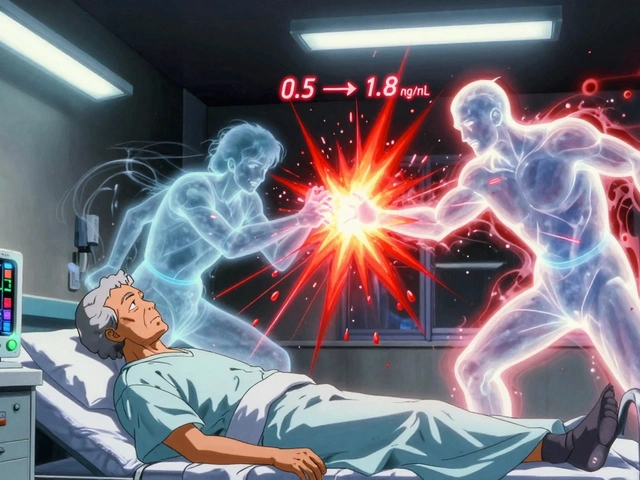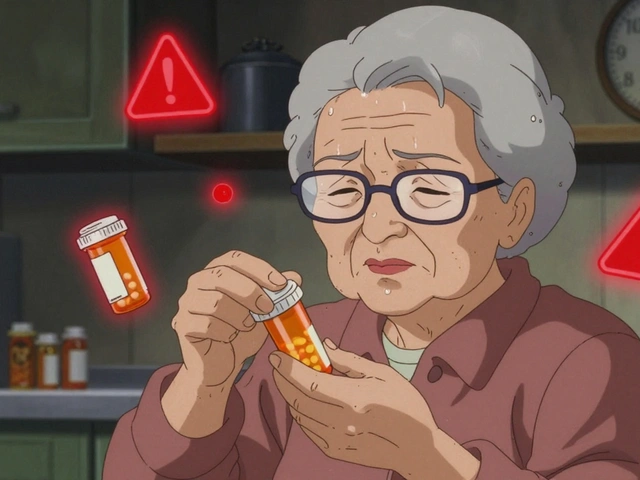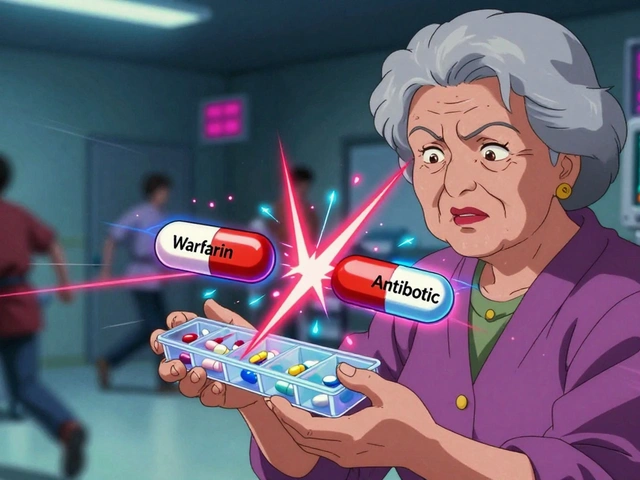Older Adult Opioid Dosing Calculator
Safe Opioid Dosing Calculator
Based on CDC, FDA, and American Geriatrics Society guidelines for older adults
Recommended Starting Dose
When older adults take opioids for pain, the risks aren’t the same as for younger people. Their bodies process drugs differently. Their balance weakens. Their minds become more sensitive to sedation. What seems like a simple prescription can lead to a fall, a hospital visit, or even death. In 2025, this isn’t a rare problem-it’s a daily reality in clinics and homes across New Zealand and beyond.
Why Opioids Are More Dangerous for Older Adults
Your body changes as you age. Your kidneys slow down. Your liver doesn’t break down drugs as quickly. You have less muscle and more fat. That means opioids stay in your system longer, building up even at low doses. The blood-brain barrier also becomes leakier, letting more of the drug reach your brain than it should. This isn’t theory. Studies show older adults are twice as likely to die from opioid-related causes compared to younger people with the same condition. In one large study of veterans aged 50 and older, those with opioid use disorder had double the risk of accidental overdose death. And it’s not just about misuse-many are taking prescriptions exactly as directed, yet still suffer serious harm.Falls: The Silent Epidemic
Falls are the leading cause of injury-related hospitalizations in people over 65. Opioids make them far more likely. How? Three main ways:- Sedation: Opioids slow down brain activity, making you drowsy and slow to react.
- Orthostatic hypotension: Your blood pressure drops when you stand up, causing dizziness or fainting.
- Hyponatremia (low sodium): Especially with tramadol, opioids can trigger this condition, leading to confusion, weakness, and unsteadiness.
Delirium: Confusion You Can’t Ignore
Delirium is sudden confusion, disorientation, or changes in awareness. It’s not dementia. It’s not depression. It’s an acute brain reaction-and opioids are a top trigger in older adults. A 2023 study from Denmark followed 75,471 people over 65 with dementia. Those who started opioids had an elevenfold increase in death risk during the first two weeks. That’s not a typo. Eleven times. Many of these patients weren’t even in pain-they were given opioids for restlessness or agitation, common symptoms of dementia that are often misdiagnosed. Doctors sometimes mistake opioid-induced delirium for worsening dementia. Patients become withdrawn, forgetful, or agitated. Families think it’s just the disease progressing. But stop the opioid, and the confusion often clears up within days.
How to Adjust the Dose: Start Low, Go Slow
There’s no one-size-fits-all dose for older adults. But there is a rule that saves lives: start low, go slow. For someone over 65, doctors should begin with 25% to 50% of the usual adult dose. For someone over 75 or with kidney or liver problems, even less may be needed. Here’s what that looks like in practice:- Instead of starting with 5 mg of oxycodone twice daily, begin with 2.5 mg once or twice a day.
- For tramadol, avoid it altogether if possible-it’s linked to hyponatremia and seizures in seniors.
- Use immediate-release forms, not long-acting or extended-release, unless absolutely necessary.
- Sleepiness during the day
- Stumbling or needing help to stand
- Confusion or trouble remembering things
- Slurred speech or slowed reactions
When to Stop: Deprescribing Is Not Failure
Many older adults stay on opioids for years-even when they no longer help. Why? Because stopping feels scary. They worry about pain returning. Doctors worry about backlash. But staying on opioids longer than needed is dangerous. The STOPPFall tool helps doctors decide when to reduce or stop opioids in people at risk of falling. It’s not about cutting pain relief-it’s about replacing it with safer options. Deprescribing should be gradual. Sudden withdrawal can cause nausea, anxiety, sweating, or even seizures. A good plan:- Confirm the opioid is still needed for pain control.
- Replace it with non-opioid options first: acetaminophen, physical therapy, heat/cold therapy, or nerve blocks.
- Reduce the dose by 10% to 25% every 1-2 weeks.
- Watch for withdrawal symptoms and adjust speed as needed.
- Reassess pain and function weekly.
The Communication Gap
Doctors often don’t talk about opioid risks with older patients. And patients rarely ask. A study in JAMA Network Open found nearly half of primary care doctors felt unsure how to safely taper opioids. At the same time, older adults mostly worry about addiction-not falls, confusion, or heart risks. They don’t know that physical dependence can happen in just a few days. They don’t know that opioids can make dementia worse. Trust is the key. If a patient doesn’t feel heard, they won’t agree to stop. If a doctor doesn’t explain the risks clearly, they can’t make a safe choice. The best conversations start with: “I want to make sure you’re not at risk for falls or confusion. Let’s look at your pain plan together.”What Works Better Than Opioids
Opioids aren’t the only option. In fact, they’re rarely the best one.- Physical therapy: Strengthens muscles, improves balance, reduces pain from arthritis or back issues.
- Acupuncture: Proven to help chronic back and knee pain in seniors.
- Cognitive behavioral therapy (CBT): Helps change how the brain processes pain signals.
- Topical creams: Capsaicin or lidocaine patches avoid systemic side effects.
- Non-opioid pills: Acetaminophen (at safe doses) and NSAIDs (used cautiously) often do the job.
What Families Should Watch For
If you’re caring for an older relative on opioids, pay attention to:- Do they seem unusually sleepy during the day?
- Have they started stumbling or holding onto walls to walk?
- Do they forget names, repeat questions, or seem confused after starting the medication?
- Have they had any falls-even minor ones-in the past few months?
The Bigger Picture
Between 2005 and 2014, emergency room visits for opioid problems in older adults jumped by over 110%. In Denmark, nearly half of dementia patients were prescribed opioids. These aren’t outliers-they’re symptoms of a system that still treats older adults like younger ones. Guidelines from the CDC and FDA now stress caution. Professional groups like the American Geriatrics Society say opioids should be a last resort. But change is slow. Many prescriptions still start too high, last too long, and aren’t reviewed often enough. The future is clearer: safer pain management means fewer opioids, more movement, better communication, and tools like STOPPFall to guide decisions. But until then, the burden falls on families and clinicians to question, monitor, and choose wisely.Are opioids ever safe for older adults?
Yes-but only when absolutely necessary, at the lowest possible dose, and for the shortest time. They should never be the first choice. Non-opioid options like physical therapy, acetaminophen, or topical treatments are safer and often just as effective for chronic pain in seniors.
Can opioids cause dementia?
Opioids don’t cause dementia, but they can trigger or worsen delirium-a sudden, reversible confusion that looks like dementia. In people already living with dementia, opioids can accelerate cognitive decline and increase death risk by up to elevenfold in the first two weeks of use.
Why is tramadol especially risky for seniors?
Tramadol can cause hyponatremia (low sodium), which leads to dizziness, confusion, and falls. It also interacts with many common medications and is broken down by enzymes that become less efficient with age. For older adults, it’s often more dangerous than stronger opioids like oxycodone.
How long does it take for opioids to cause dependence in older adults?
Physical dependence can develop in as little as 5 to 7 days, even at prescribed doses. This isn’t addiction-it’s the body adapting. But it makes stopping harder and increases withdrawal risk. That’s why gradual tapering is essential.
What should I do if my parent is on opioids and keeps falling?
Don’t wait. Talk to their doctor immediately. Ask if the opioid is still needed, whether the dose can be lowered, or if it can be replaced with a safer option. Consider using the STOPPFall tool as a guide. Also, get a home safety check-remove rugs, install grab bars, and ensure good lighting.
Is it okay to stop opioids cold turkey in older adults?
No. Stopping suddenly can cause severe withdrawal: nausea, vomiting, sweating, anxiety, muscle aches, and even seizures. Always taper slowly under medical supervision. A typical plan reduces the dose by 10%-25% every 1-2 weeks, with close monitoring.









15 Comments
Donald Frantz
Nov 21 2025Opioids in seniors aren't just risky-they're often unnecessary. I've seen 78-year-olds on oxycodone for knee pain that physical therapy could've fixed in six weeks. The system rewards prescribing over rehab. It's profit-driven, not patient-driven.
Simone Wood
Nov 21 2025My mum was on tramadol for 14 months after a hip fracture. She started forgetting my name, tripping over air. The doctor said it was 'just aging.' I pulled her off it cold. She cried for three days. Then she walked without a cane. No one warned us. No one cared.
Julia Strothers
Nov 22 2025They're pushing this 'deprescribing' nonsense because Big Pharma lost the opioid war and now they're laundering guilt through geriatric guidelines. You think this is about safety? No. It's about control. They want you dependent on their 'safe alternatives'-which are just cheaper, less profitable, and more bureaucratic.
Erika Sta. Maria
Nov 23 2025wait so if opioids make you fall then why do people take them? like if its so dangerous then why is it even legal? i mean its not like we dont have weed or something to chill out with right? also my tata took morphine for cancer and he was fine until he died, so maybe its not the drug its the age?
Nikhil Purohit
Nov 24 2025Real talk: I'm a physio in Delhi. We see this every day. Grandpas on opioids because their doctor didn't know how to refer them. We get them off it, start them on aquatic therapy, and within 3 weeks they're walking better than before. The real crisis isn't pain-it's access to non-drug care. And yes, tramadol is a nightmare for seniors. Avoid like plague.
Debanjan Banerjee
Nov 25 2025Let’s be precise: the 28% increased fracture risk in the 2,341-person study was not statistically significant (p=0.07), but the OR of 1.28 with 95% CI of 0.97–1.68 still suggests clinical relevance. The real issue is polypharmacy. 62% of seniors on opioids are also on benzodiazepines or anticholinergics. That’s a pharmacokinetic bomb. STOPPFall is underutilized because EMRs don’t integrate it. Fix the tech, not just the dosing.
Steve Harris
Nov 27 2025I work in hospice. I’ve watched families panic because Grandpa’s 'acting weird' after a new pain script. We sit down, explain delirium, and ask: 'Would you rather he be in pain or confused?' Most say 'neither.' So we taper. Slowly. With love. And guess what? They thank us. Not because the pain vanished-but because their dad remembered their name again.
Michael Marrale
Nov 27 2025Did you know the FDA approved a new opioid in 2023 that’s 'safe for seniors'? It’s not true. The trial had 12 participants over 75. The rest were 30-year-olds. They call it 'precision medicine.' I call it corporate fraud. They’re still selling death in pill form and calling it innovation.
David vaughan
Nov 28 2025My grandma took 5mg oxycodone once a day for 8 months. No falls. No confusion. Just quiet relief. She died peacefully at 91. The 'start low, go slow' rule works-if you actually follow it. Not everyone needs to be terrified. Some people need dignity. And pain relief. Not a lecture.
Cooper Long
Nov 29 2025Opioid use in geriatric populations requires individualized risk-benefit analysis grounded in evidence-based guidelines. The burden of proof lies with prescribers to demonstrate therapeutic necessity and continuous reassessment.
Sheldon Bazinga
Nov 30 2025Oh wow so now we’re blaming the drugs and not the fact that old people are just weak? My grandad smoked two packs a day, drank whiskey, and climbed ladders at 80. He didn’t need a babysitter. He needed a spine. Stop coddling seniors. They’re not fragile glass dolls. Just let them live.
Sandi Moon
Dec 1 2025It's fascinating how Western medicine has pathologized aging. In traditional societies, elders were revered. Here, we medicate their decline into oblivion. Opioids are not the villain. The system that sees a 70-year-old as a liability, not a legacy, is the true disease.
Kartik Singhal
Dec 1 2025Bro, if you're scared of opioids, why not just use CBD? It's natural, legal in 47 states, and your grandma won't turn into a zombie. Also, I heard the WHO is secretly funded by Big Pharma to push deprescribing so they can sell more antidepressants. 🤫💊
Logan Romine
Dec 2 2025So let me get this straight. We're terrified of opioids making old people fall... but we're fine with them falling because their knees are shot from decades of walking? We're scared of delirium... but we're fine with them being bored, lonely, and ignored? Maybe the real opioid is loneliness. And we're prescribing it by the gallon.
Chris Vere
Dec 3 2025The issue is not the drug. It is the lack of holistic care. Pain is not only physical. It is emotional. It is social. It is spiritual. When we reduce it to a pill, we fail the human being.